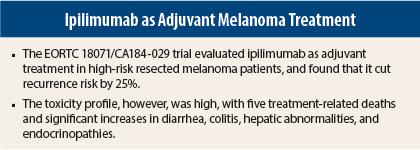Ipilimumab (Yervoy) has transformed the treatment of metastatic melanoma, producing long-term responses in about 20% of patients. A phase III study has now evaluated its impact in the adjuvant setting, and the results are a bit less striking.
Primary Endpoint
The European Organisation for Research and Treatment of Cancer (EORTC) 18071/CA184-029 trial was presented at the 2014 ASCO Annual Meeting by Alexander M. Eggermont, MD, PhD, Director General of the Gustave Roussy Cancer Center in Villejuif, France.1 Adjuvant ipilimumab reduced the risk of recurrence by roughly 25%, compared to placebo, in the study of 951 surgically treated high-risk stage III melanoma patients.
“The study met its primary endpoint of a significant improvement in recurrence-free survival with 10 mg/kg ipilimumab vs placebo,” Dr. Eggermont reported. “Results from prespecified subgroup and sensitivity analyses show a consistent pattern, with hazard ratios favoring ipilimumab relative to placebo.”
Melanoma expert Steven J. O’Day, MD, Director, Clinical Research, Beverly Hills Cancer Center, Beverly Hills, California, who moderated a press briefing where the results were presented, remarked, “This is the first study to demonstrate the clinical benefit of ipilimumab in stage III melanoma. The magnitude of the clinical benefit, the side effects, and the dosing schedule warrant further follow-up and additional comparative studies with interferon, which are ongoing,” he said.
“Ipilimumab was not shown to be superior,” Dr. O’Day emphasized. “We need to be cautious.”
Adjuvant Melanoma: An Unmet Need
At a press briefing, Dr. Eggermont emphasized that high-risk patients with resected disease need better treatment options. Also at the ASCO Annual Meeting, his research team presented a meta-analysis of 15 randomized trials involving more than 7,500 patients. The analysis showed that adjuvant interferon-alfa reduces the risk of recurrence by just 14%, and the risk of death by only 9%.2
“Although there are approved adjuvant therapies, there is still an unmet need in this group of patients,” he said. “Ipilimumab was the first drug approved for metastatic melanoma, based on an overall survival improvement, so the EORTC trial is the first ever with a melanoma drug that has improved survival.”
Study Details
The study population included 951 stage III patients, all with lymph node involvement, who had undergone complete resection. By the ipilimumab and placebo arms, respectively, stage III disease was present in 18% and 21%, stage IIIB in 45% and 43%, stage IIIC with one to three positive nodes in 15% and 17%, respectively, and stage IIIC with at least four positive nodes in 20% and 21%, respectively. Approximately half had microscopic nodal involvement and half macroscopic involvement (ie, palpable nodes).
Patients were randomly assigned to placebo or ipilimumab at 10 mg/kg every 3 weeks for four doses, then continued at 3-month intervals for up to 3 years.
At a median follow-up of 2.7 years, there were 294 recurrences in the placebo group compared to 234 in the ipilmumab group. Three-year recurrence-free survival rates were 34.8% and 46.5%, respectively (hazard ratio [HR] = 0.75; P = .0013), and median recurrence-free survival was 17.1 months vs 26.1 months with ipiliumumab, Dr. Eggermont reported.
Overall, ipilimumab reduced recurrences by 25%, but the hazard ratios were higher in some subsets: those with ulceration of the primary lesions (HR = 0.67) and those with microscopic disease (HR = 0.68), he noted.
Discontinuation due to disease progression was noted for 28% of the ipilimumab arm and 57.6% of the placebo arm.
Toxicity Observed
The trade-off appears to be toxicity, Dr. Eggermont acknowledged. There were five treatment-related deaths (1.1%) in the ipilimumab arm: three due to colitis (two with gastrointestinal perforation), one due to myocarditis, and one related to Guillain-Barré syndrome. No deaths related to treatment occurred in the placebo arm.
Nearly 50% of ipilimumab-treated patients discontinued the drug due to side effects, most of them within the first 3 months. Generally, however, “the safety profile is consistent with that observed in advanced melanoma, although the incidence of some immune-related adverse events [eg, endocrinopathies] was higher in this study,” he said. “Most immune-related adverse events were manageable and resolved with established treatment algorithms.”
Diarrhea of any grade was observed in 41.4% with ipilimumab and 16.7% with placebo; 9.6% and 0.4% of these cases, respectively, were grade 3. Colitis occurred in 15.9% and 1.3%, respectively, and was grade 3/4 in 7.6% and 0.2%.
Endocrine disorders (hypophysitis, hypothyroidism) were also a concern for 37.6% of the ipilimumab arm vs 6.5% of the placebo arm. Hepatic issues were observed in 25.1% and 4.4%, respectively.
“We are not attempting to downplay the toxicity,” Dr. Eggermont said at the press briefing. “In the adjuvant setting, the discussion is about RISK, spelled in capital letters.”
The majority of these grade 2–4 immune-related adverse events resolved within 6 weeks, including 89% of the skin toxicities, 94% of the gastrointestinal toxicities, and 95% of the hepatic abnormalities, but endocrine effects resolved in only 56% of patients and at a median of 31 weeks.
Better Than Interferon?
In commenting on the EORTC 18071 findings at the press briefing, Dr. O’Day pointed out that, while no head-to-head comparisons have yet generated data, the benefits seen with adjuvant ipilimumab are in line with what is achieved with the age-old interferon.
“Ipilimumab shows activity in the adjuvant setting. There is a delay in recurrence. However, I would argue that this delay is about 10% at 3 years, which is comparable to interferon,” he said.
Dr. Eggermont countered that in some subgroups, ipilimumab does seem better than interferon. His meta-analysis found that in patients with clinically palpable disease, hazard ratios with interferon or pegylated interferon ranged from 0.78 to 0.91, whereas in the EORTC study of ipilimumab, hazard ratios were 0.68 to 0.83.
“There was a striking difference between the treatments in patients with palpable disease,” he observed. “And in the end, the hazard ratio was 0.75, which we don’t see with other treatments.”
Dr. O’Day also highlighted the toxicity, “which seemed at a slightly higher level than we see in the metastatic setting, including five treatment-related deaths,” he said. “We can salvage these patients in the metastatic setting, not just by improving overall survival but also by producing long-term survival/cure. The tolerance for toxicity and deaths in the adjuvant setting is a different bar.”
He also stressed the need to evaluate the drug for overall survival. “In the metastatic setting, ipilimumab is underwhelming in terms of progression-free survival but has impressive effects on overall survival,” he said, “so we need to wait for the overall survival results and the direct comparison with interferon before we make firm conclusions about its role in the adjuvant setting.”
While Dr. O’Day also pointed out that interferon compounds and doses differ between the EORTC and U.S. cooperative group trials, Dr. Eggermont noted that his meta-analysis included high-dose, intermediate-dose, and low-dose interferons. “It was an independent patient data meta-analysis, which is the highest quality meta-analysis you can do,” he argued.
Adjuvant Therapy Issues
Finally, the issue of a placebo-controlled trial for adjuvant treatment was raised, with Dr. Eggermont indicating that in Europe, the use of adjuvant therapy is not a standard of care.
Dr. O’Day noted that in the United States, adjuvant therapy is a standard but not the standard. “It’s controversial,” he acknowledged. “It’s consistently shown disease-free but not overall survival benefits, though some studies have shown a survival benefit.”
Antonio Ribas, MD, a melanoma expert at the University of California, Los Angeles, had the last word on this at the press briefing: “Based on evidence, regulatory agencies have concluded that being on interferon treatment benefits patients.”
The question of just which adjuvant approach is better may be answered by the ongoing phase III ECOG 1609 trial, which is comparing two doses of ipilimumab (3 mg/kg and 10 mg/kg) to high-dose interferon. ■
Disclosure: Dr. Eggermont is a consultant/advisor for Bristol-Myers Squibb. Dr. O’Day reported no potential conflicts of interest. Dr. Ribas reported a consultant or advisory role with Amgen, Compugen, GlaxoSmithKline, Genentech, Merck, Novartis, and Pierre Fabre, stock ownership with Kite Pharma and Flexus Bio, and holds a position as an advisory board member and/or consultant for Merck.
References
1. Eggermont AM, Chiarion-Sileni V, Grob JJ, et al: Ipilimumab versus placebo after complete resection of stage III melanoma: Initial efficacy and safety results from the EORTC 18071 phase III trial. ASCO Annual Meeting. LBA 9008. Presented June 2, 2014.
2. Suciu S, Ives N, Eggermont AM, et al: Predictive importance of ulceration on the efficacy of adjuvant interferon-α: An individual patient data meta-analysis of 15 randomised trials in > 7500 melanoma patients. ASCO 2014 Annual Meeting. Abstract 9067. Presented May 31, 2014.




